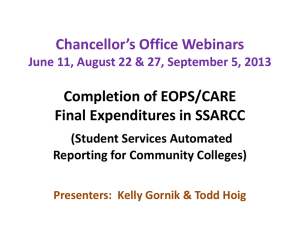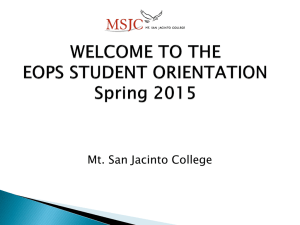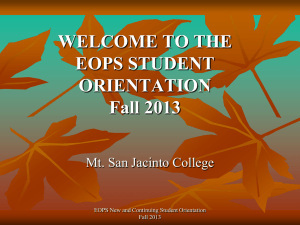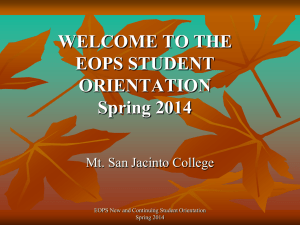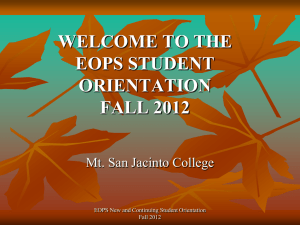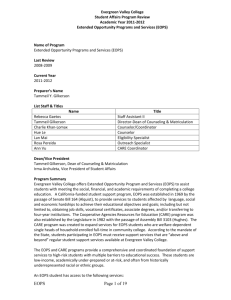The EOPS and CARE programs provide a
advertisement
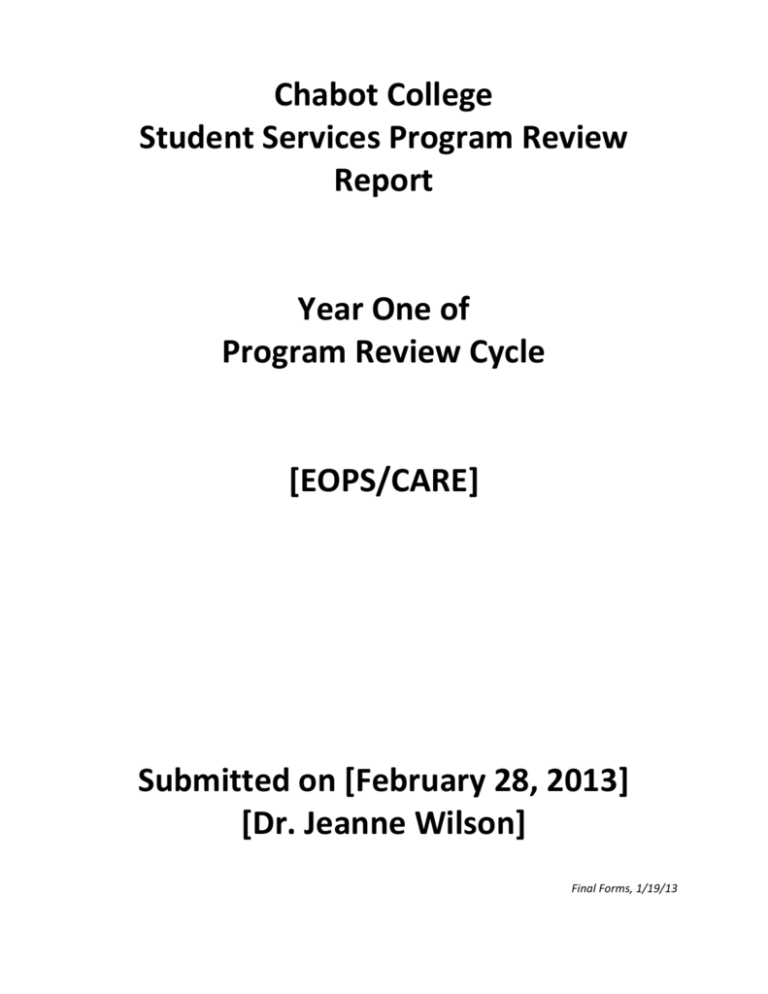
Chabot College Student Services Program Review Report Year One of Program Review Cycle [EOPS/CARE] Submitted on [February 28, 2013] [Dr. Jeanne Wilson] Final Forms, 1/19/13 Table of Contents Section 1: Who We Are ............................................................ 1 Section 2: Where We Are Now ................................................. 2 Section 3: The Difference We Hope to Make ............................. 3 Required Appendices: A: Budget History .........................................................................................4 B: Student Learning and Service Area Outcomes Inventory .........................5 E: New Initiatives .........................................................................................6 F2F1: New Faculty Requests.........................................................................7 F2: Classified Staffing Requests ....................................................................8 F3: FTEF Requests ........................................................................................9 F5: Supplies and Services Requests ............................................................10 F6: Conference/Travel Requests ................................................................11 F7: Technology and Other Equipment Requests ........................................12 F8: Facilities Requests ................................................................................13 2 1. Who We Are Chabot College offers Extended Opportunity Program and Services (EOPS) to assist students with meeting the social, financial, and academic requirements of completing a college education. A California-funded student support program, EOPS was established in 1969 by the passage of Senate Bill 164 (Alquist), to provide services to students affected by language, social and economic hardships to achieve their educational objectives and goals; including but not limited to, obtaining job skills, vocational certificates, associate degrees, and/or transferring to four-year institutions. The Cooperative Agencies Resources for Education (CARE) program was also established by the Legislature in 1982 with the passage of Assembly Bill 3103 (Hughes). The CARE program was created to expand services for EOPS students who are welfare-dependent single heads of household enrolled full-time in community college. According to the mandate of the State, students participating in EOPS must receive support services that are “above and beyond” regular student support services available at Chabot College. The EOPS and CARE programs provide a comprehensive and coordinated foundation of support services to high-risk students with multiple barriers to educational success. These students are low-income, academically under-prepared or at-risk, and often from historically underrepresented racial or ethnic groups. An EOPS& CARE student s has access to the following services: Academic / Career&Personal Counseling Assistance in completing federal, state, and college financial aid applications Complimentary graduation cap and gown Counseling workshops Fee waivers for UC and CSU admission application Fieldtrips related to academic motivation and career exploration Grants based on state funding and student eligibility Monitoring of academic progress Newsletter regarding EOPS updates and deadlines Priority Registration Referrals to on- and off-campus resources for academic and career support Scholarships Scholarship recommendation letters Study skills instruction and mentoring Textbook vouchers Transfer assistance to four-year schools Tutorial services University transfer letters of recommendation The CARE Program provides single parent students with additional support services including grant funds, school supplies and meal tickets. Academic Year(s) 1990’s 2011-2012 2012-2013 Students Served Full-time FTEF Part-time FTEF Full-time Staff Part- time Staff 590 4 Counselors 0 3 0 269 2 Counselors 0 3 0 275 1 Counselor 0 3 0 The EOPS/CARE staff consists of an EOPS Director who dedicates 5% of his time (VP of Student Services) to EOPS/CARE, a full-time Coordinator/Counselor, two part-time counselors, and three full-time classified staff. 1 2. Where We Are Now Describe how changes in resources provided to your office have impacted your achievements Due to statewide budget cuts in 2010/11categorical programs, including EOPS, CARE, CalWORKs and DSPS, saw our program budget(s) slashed by 40%! As a result cutbacks have pared down the program as EOPS book vouchers,which are granted each semester to eligible students, were reduced by 50% from $400 to $200 per semester. We also had to reduce hours for student assistants, extra tutoring services for students, student activities and supplies. All services imperative to student success. Program Achievements /What We Are Most Proud Of EOPS Blue Ribbon Appreciation Week Each Spring EOPS sponsors a Blue Ribbon Appreciation Luncheon for EOPS students to recognize and appreciate an on campus faculty, staff and/or administrator with a blue ribbon that reads, “Who I Am Makes A Difference”. Students are able to thank Chabot faculty, staff and administrators who have gone “Above &Beyond” to ensure their success. CARE Holiday Celebration Each year CARE holds its annual Holiday Celebration for the CARE students and their children. Chabot , Las Positas, and District faculty, staff, administrators and students, contribute gifts for the children and they are awarded an EOPS Holiday Angel Certificate of Appreciation for their contribution to the CARE Holiday Celebration. Over the last three years approximately 108 parents and 396 children were helped through these efforts. EOPS/CARE End of Year Celebration Each May EOPS & CARE holds its annual Student Recognition Celebration. All students received Certificates of Achievement in recognition of their successful academic year. In the last three years one hundred seventeen (117) students graduated, transferred and/or received an Associate in Arts or Associate Science degree. Twenty four (24) students completed certificates of achievement or completion. Twenty eight (28) maintained a 3.5 or above cumulative grade point average and out of the (28), fifteen (15) students maintained a 4.00 cumulative GPA. Thank you to The Associated Students of Chabot College (ASCC) for co-sponsoring all of the above events. Scholarships Awarded to EOPS/CARE Students In the last three years thirty (30) students received a total of forty-eight (48) scholarships and/or awards. Eighteen (18) of the scholarships were awarded by the ASCC; six students received the Melinda Matsuda EOPS Scholarship Award, six more received the Melinda Matsuda Striving Black Brothers Scholarship, three the Region IV East Bay Consortium Scholarship, six the Chabot College Bookstore Scholarship, one the Schuyer C. Joynee Scholarship, one the Gladiator of the Year Award, one the outstanding Student Assistant and one the Athletics Scholarship. Chabot EOPS & Social Networking In an effort to increase student success our EOPS website has been enhanced to make it a resource where students are able to print forms (Mid-term Progress Reports, Priority Registration), find out about upcoming workshops and get to know the staff. A student list-serve was also created to remind students 2 of upcoming events, the three program contacts etc. An EOPS Facebook (EOPS Chabot) page was created in order to remind students of upcoming deadlines and events. Students now also receive reminders for appointments by email and phone. Striving Black Brothers Coalition (SBBC) The Striving Black Brothers Coalition is a unique support system designed to help African American males understand their purpose in the collegiate arena and in life, by developing an authentic sense of self, committing to a purpose and building meaningful relationships with peers, family, and Chabot College faculty.The SBBC’s activities over the last three years have include raising over $6,000 for educational scholarships and Southern California College & University tours, participating as panelist for numerous African American Male Summits in the Bay Area and Southern California and attending weekly meetings/workshops that include the SBBC Reading Club. MentorsAmong Us An important component of the SBBC is the Mentors Among Us Program. Each of the 24-30 SBBC members are matched with a mentor who is a faculty, staff or administrator at Chabot College. Over the years three Chabot Presidents, one LPC President, Vice-Presidents, Deans, Board Members and a host of faculty and classified professionalshave served as mentors to a Striving Black Brother. What are your Student Learning Outcomes (SLOs) and Service Area Outcomes (SAOs), and what progress have you made toward achieving them? What we will continue to improve? Ongoing SLO Students are mastering the learning objectives as set by our ongoing SLOof: EOPS/CARE students will learn to utilize the EOPS/CARE program by completing the three EOPS program contacts, as mandated in Title V regulations, each semester to ensure students reach their educational goals in a timely manner.Data provided by Chabot’s Office of Institutional Research shows that from Fall2001-Spring 2011, persistence rates of new students who receive the Matriculation services of orientation, assessment, counseling, or who participated in Extended Opportunities Programs & Services (EOPS) have higher persistence rates than new students without those services. It is of great significance to note that EOPS students have the highest persistence rates (81%) over Non-EOPS students. The heart of the EOPS program is the design of academic support services that are specifically designed for each student’s needs. Based on the personalized program services and regular follow-up, faculty and staff work directly with individuals to monitor and develop intervention strategies and referrals to assist students. The helping hand and personal encouragement is the cornerstone that leads to student achievement and success, as proven by the institutional data. Discuss important trends that will have a significant impact on your unit over the next three years. What opportunities and challenges do your foresee in the next three years? New SOA Opportunities Important trends that are coming out of the State Chancellor’s Office that will significantly impact EOPS and CARE students over the next three years will be that of SB 1456 (Lowenthal), the Student Success 3 Act of 2012. Areas that will have the greatest effect on EOPS/CARE students will be Priority Registration, Repeatability, and Financial Aid Reform. The new regulatory changes to Priority Registration, proposed for Fall 2014, will mandate a new tiered priority that may have adverse effect for our most vulnerable students.Since students will begin to lose their priority registration if they have not completed the full Matriculation process of assessment, orientation and counseling, we in EOPS will create a new SAO to measure our efforts to inform students of the impending changes to priority registration, course repeatability and financial aid, in order to ensure the effectiveness and efficiency of the program continues for students. New Services Area Outcomes (SAO) EOPS students utilizing these services will be able to: 1. Acknowledge that EOPS/CARE program(s) and services increased their academic confidence and academic goal clarity. Performance Indicator (How Measured): 85% or higher will have acknowledged that the EOPS/CARE program and services increased their academic confidence and academic goal clarity. 2. Confirm they have completed the full Matriculation process at Chabot as indicated by assessment scores, previous college transcripts and/or banner screens. Performance Indicator (How Measured):95% or higher will demonstrate that theyhave completed the full Matriculation process at Chabot College as indicated by assessment scores, previous college transcripts and/or banner screens. Technology, facilities, equipment request and student trends The 21st century student has an increased demand and reliance on social media, computer access, discussion boards (Blackboard), digital materials and online homework submission. With such a reliance on computers it is “not” beneficial to Chabot EOPS & CARE students to be subjected to such antiquated library and tutorial centers with insufficient computers and staffing for tutors. We are in support of any departmental initiativesrequested by the tutorial center and/or library, requesting funds for technology, facilities and equipment, as it would be a direct benefit to our EOPS students. 4 3. The Difference We Hope to Make Review the Strategic Plan goal and key strategiesat http://www.chabotcollege.edu/prbc/StrategicPlan/SPforPR.pdfprior to completing your narrative. Please complete Appendices E (New Initiatives) and F1-3 and 5-8 (Resource Requests) as relevant to your needs to further detail your narrative. Limit your narrative to three pages, and be very specific about what you hope to achieve, why, and how. What initiatives would you like to undertake to improve or strengthen your unit or to address demand for your services? What initiatives are underway in your area, or could you begin, that would support the achievement of our new Strategic Plan goal and strategies and/or improve student learning? Identify specific, measurable goals and the resources needed to achieve them. At this time we have no “new” initiatives that will require funding outside of the purview of the EOPS & CARE budgets. Chabot College’s EOPS/CARE Program is in direct alignment with the College’s goal and strategic plan of “Increasing the number of students that achieve their educational goal within a reasonable time by clarifying pathways and providing more information and support.” The EOPS & CARE Programs directly serves students to ensure they are successful in their academic and personal pursuits. The direct services and case managed support ensures students have access to resources that are “over and above” what the College offers. This has direct correlation to the high numbers of students that graduate and transfer from the program. 5 Appendix A: Budget History and Impact Audience: Budget Committee, PRBC,and Administrators Purpose: This analysis describes your history of budget requests from the previous two years and the impacts of funds received and needs that were not met. This history of documented need can both support your narrative in Section A and provide additional information for Budget Committee recommendations. Instructions: Please provide the requested information, and fully explain the impact of the budget decisions. Category Classified Staffing (# of positions) Supplies & Services Technology/Equipment Other TOTAL 2011-12 Budget Requested N/A 2011-12 Budget Received N/A 2012-13 Budget Requested N/A 2012-13 Budget Received N/A $0.00 $0.00 $0.00 $0.00 1. How has your investment of the budget monies you did receive improved your Service Area Outcomes? When you requested the funding, you provided a rationale. In this section, assess if the anticipated positive impacts you projected have, in fact, been realized. N/A 2. What has been the impact of not receiving some of your requested funding? How has your ability to serve the college and our students been impacted, or safety compromised? N/A 6 Appendix B: Student Learning and Service Area Outcomes Inventory Audience: PRBCand Administrators Purpose: This analysis enables us to track progress on key learning and student service goals, and to meet our accreditation standards. Instructions: Please provide the requested information, noting ongoing SLOs/SAOs as well as any new goals. How Measured SLO/SAO SLO #1 (Ongoing) EOPS/CARE students will learn to utilize the EOPS/CARE program by completing the threemandated EOPS program contacts each semester to ensure students reach their educational goals in a timely manner. SAO #1:(Ongoing) Collaborate with other student services programs such as Daraja/Puente, Aspire, and Transfer, Employment, Career Services in offering workshops and campus tours to 4 year Colleges and Universities. SAO #2:(New) Acknowledge that EOPS/CARE program(s) and services increased their academic confidence and academic goal clarity. SAO #3:(New) Confirm students have completed the full Matriculation process at Chabot as indicated by assessment scores, previous college transcripts and/or banner screens. Results/Discussion 85% or higher will utilize the EOPS/CARE program by completing the threemandated EOPS program contacts each semester to ensure students reach their educational goals in a timely manner. 90% Collaboration with other student services programs such as Daraja/Puente, Aspire, and Transfer, Employment, Career Services in offering workshops and campus tours to 4 year Colleges and Universities. Completed all 3 program contacts Fall 2010 77% Spring 2011 63% Fall 2011 79% Spring 2012 77% EOPS was able to successfullycollaboratewith Daraja/Puente, Aspire (TRIO), Transfer, Employment, and Career Services in offering twelve combined workshops and campus tours to 4 year Colleges and Universities in Spring 2012 and Fall 2012. 85% or higher will have acknowledged that the EOPS/CARE program and services increased their academic confidence and academic goal clarity. N/A 95% or higher will demonstrate that they have completed the full Matriculation process at Chabot College as indicated by assessment scores, previous college transcripts and/or banner screens. N/A 7 Appendix E: Proposal for New Initiatives (Complete for each new initiative) Audience: Deans/Unit Administrators, PRBC, Foundation, Grants Committee, College Budget Committee Purpose: A “New Initiative” is a new project or expansion of a current project that supports our Strategic Plan. The project will require the support of additional and/or outside funding. The information you provide will facilitate and focus the research and development process for finding both internal and external funding. How does your initiative address the college's Strategic Plan goal, or significantly improve student learning? N/A What is your specific goal and measurable outcome? What is your action plan to achieve your goal? Target Required Budget (Split out Completion personnel, supplies, other Date categories) Activity (brief description) How will you manage the personnel needs? New Hires: Faculty # of positions Classified staff # of positions Reassigning existing employee(s) to the project; employee(s) current workload will be: Covered by overload or part-time employee(s) Covered by hiring temporary replacement(s) Other, explain At the end of the project period, the proposed project will: Be completed (onetime only effort) Require additional funding to continue and/or institutionalize the project (obtained by/from): Will the proposed project require facility modifications, additional space, or program relocation? No Yes, explain: Will the proposed project involve subcontractors, collaborative partners, or cooperative agreements? No Yes, explain: Do you know of any grant funding sources that would meet the needs of the proposed project? No Yes, list potential funding sources: 8 Appendix F1: Full-Time Faculty or Counselors/Adjunct Staffing Request(s) [Acct. Category 1000] Audience: Faculty Prioritization Committeeand Administrators Purpose: Providing explanation and justification for new and replacement positions for full-time faculty/counselors and adjuncts Instructions: Please justify the need for your request. Discussanticipated improvements in student learning and contribution to the Strategic Plangoal. Cite evidence and data to support your request, including enrollment management data (EM Summary by Term) for the most recent three years, student success and retention data , and any other pertinent information. Data is available at http://www.chabotcollege.edu/ProgramReview/Data2012.cfm. 1. Number of new faculty or counselors requested in this discipline: _1___ 2. If you are requesting more than one position, please rank order the positions. Position Description 1. Counselor (EOPS) Counselor/Instructor 2. 3. Rationale for your proposal. Please use the enrollment management data. Additional data that will strengthen your rationale include FTES trends over the last 5 years,persistence,FT/PT faculty ratios,CLO and PLO assessment results and external accreditation demands. The EOPS program has lost two full time counseling positions over the last three years due to retirements and a voluntary department transfer. While our adjunct faculty possess a plethora of counseling knowledge and expertise, the continuity of a full time counseling faculty member who can participate in shared governance committees and who students can build an invariable relationship with, is ideal for this type of intrusive counseling program. Partial funding of this position could be subsidized through EOPS categorical funds(50% - 75%) with a partial match (25% - 50%) from the general fund (to assist with the EOPS Title V mandated “college match” requirements ($220,444 College match required annually). 4. Statements about the alignment with the strategic plan and your student learning and service area goals are required. Indicate here any information from advisory committees or outside accreditation reviews that is pertinent to the proposal. With the broad array of academic and personal counseling services engaged in; it is our goal to get students onto their “critical path quickly” and it would strengthen the program to hire a full-time counselor to assist with these efforts. If hired, a full time counselor will be able to help “Increase the number of students that achieve their educational goal within a reasonable time by clarifying pathways and providing more information and support” to our EOPS and CARE students. 9 Appendix F2: Classified Staffing Request(s) including Student Assistants [Acct. Category 2000] Audience: Administrators, PRBC Purpose: Providing explanation and justification for new and replacement positions for full-time and part-time regular (permanent) classified professional positions(new, augmented and replacement positions).Remember, student assistants are not to replace Classified Professional staff. Instructions: Please justify the need for your request. Discuss anticipated improvements in student learning and contribution to the Strategic Plan goal, safety, mandates, accreditation issues. Please cite any evidence or data to support your request. If this position is categorically funded, include and designate the funding source of new categorically-funded position where continuation is contingent upon available funding. 1. Number of positions requested: __N/A____ 2. If you are requesting more than one position, please rank order the positions. Position Description 1. 2. 3. Rationale for your proposal. 4. Statements about the alignment with the strategic plan and program review are required. Indicate here any information from advisory committees or outside accreditation reviews that is pertinent to the proposal. 10 Appendix F3: FTEF Requests Audience: Administrators, CEMC, PRBC Purpose: To recommend changes in FTEF allocations for subsequent academic year and guide Deans and CEMC in the allocation of FTEF to disciplines. For more information, see Article 29 (CEMC) of the Faculty Contract. Instructions: In the area below, please list your requested changes in course offerings (and corresponding request in FTEF) and provide your rationale for these changes. Be sure to analyze enrollment trends and other relevant data athttp://www.chabotcollege.edu/ProgramReview/Data2012.cfm. N/A 11 Appendix F5: Supplies & Services Requests [Acct. Category 4000 and 5000] Audience: Administrators, Budget Committee, PRBC Purpose: To request funding for supplies and service, and to guide the Budget Committee in allocation of funds. Instructions: In the area below, please list both your current and requested budgets for categories 4000 and 5000 in priority order. Do NOT include conferences and travel, which are submitted on Appendix M6. Justify your request and explain in detail any requested funds beyond those you received this year. Please also look for opportunities to reduce spending, as funds are very limited. Project or Items Requested N/A 2012-13 Budget Requested Received $ 2013-14 Request $ 12 Rationale Appendix F6: Conference and Travel Requests [ Acct. Category 5000] Audience: Staff Development Committee,Administrators, Budget Committee, PRBC Purpose: To request funding for conference attendance, and to guide the Budget and Staff Development Committees in allocation of funds. Instructions:Please list specific conferences/training programs, including specific information on the name of the conference and location. Note that the Staff Development Committee currently has no budget, so this data is primarily intended to identify areas of need that could perhaps be fulfilled on campus, and to establish a historical record of need. Your rationale should discuss student learning goals and/or connection to the Strategic Plan goal. Conference/Training Program N/A 2013-14 Request Rationale $ 13 Appendix F7: Technology and Other Equipment Requests [Acct. Category 6000] Audience: Budget Committee, Technology Committee, Administrators Purpose: To be read and responded to by Budget Committee and to inform priorities of the Technology Committee. Instructions: Please fill in the following as needed to justify your requests.If you're requesting classroom technology, see http://www.chabotcollege.edu/audiovisual/Chabot%20College%20Standard.pdf for the brands/model numbers that are our current standards. If requesting multiple pieces of equipment, please rank order those requests. Include shipping cost and taxes in your request. Please note: Equipment requests are for equipment whose unit cost exceeds $200. Items which are less expensive should be requested as supplies. Software licenses should also be requested as supplies. Project or Items Requested N/A 2012-13 Budget Requested Received $ 2013-14 Request Rationale* $ * Rationale should include discussion of impact on student learning, connection to our strategic plan goal, impact on student enrollment, safety improvements, whether the equipment is new or replacement, potential ongoing cost savings that the equipment may provide, ongoing costs of equipment maintenance, associated training costs, and any other relevant information that you believe the Budget Committee should consider. 14 Appendix F8: Facilities Requests Audience: Facilities Committee, Administrators Purpose: To be read and responded to by Facilities Committee. Background: Following the completion of the 2012 Chabot College Facility Master Plan, the Facilities Committee (FC) has begun the task of re-prioritizing Measure B Bond budgets to better align with current needs. The FC has identified approximately $18M in budgets to be used to meet capital improvement needs on the Chabot College campus. Discussion in the FC includes holding some funds for a year or two to be used as match if and when the State again funds capital projects, and to fund smaller projects that will directly assist our strategic goal. The FC has determined that although some of the college's greatest needs involving new facilities cannot be met with this limited amount of funding, there are many smaller pressing needs that could be addressed. The kinds of projects that can be legally funded with bond dollars include the "repairing, constructing, acquiring, equipping of classrooms, labs, sites and facilities." Do NOT use this form for equipment or supply requests. Instructions: Please fill in the following as needed to justify your requests.If requesting more than one facilities project, please rank order your requests. Brief Title of Request (Project Name): N/A Building/Location: Description of the facility project. Please be as specific as possible. What educational programs or institutional purposes does this equipment support? Briefly describe how your request relates specifically to meeting the Strategic Plan Goal and to enhancing student learning? 15
